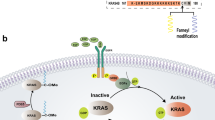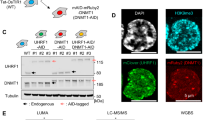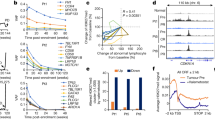Abstract
The CEBPA gene is mutated in 9% of patients with acute myeloid leukemia (AML). Selective expression of a short (30-kDa) CCAAT-enhancer binding protein-α (C/EBPα) translational isoform, termed p30, represents the most common type of CEBPA mutation in AML. The molecular mechanisms underlying p30-mediated transformation remain incompletely understood. We show that C/EBPα p30, but not the normal p42 isoform, preferentially interacts with Wdr5, a key component of SET/MLL (SET-domain/mixed-lineage leukemia) histone-methyltransferase complexes. Accordingly, p30-bound genomic regions were enriched for MLL-dependent H3K4me3 marks. The p30-dependent increase in self-renewal and inhibition of myeloid differentiation required Wdr5, as downregulation of the latter inhibited proliferation and restored differentiation in p30-dependent AML models. OICR-9429 is a new small-molecule antagonist of the Wdr5-MLL interaction. This compound selectively inhibited proliferation and induced differentiation in p30-expressing human AML cells. Our data reveal the mechanism of p30-dependent transformation and establish the essential p30 cofactor Wdr5 as a therapeutic target in CEBPA-mutant AML.
This is a preview of subscription content, access via your institution
Access options
Subscribe to this journal
Receive 12 print issues and online access
$259.00 per year
only $21.58 per issue
Buy this article
- Purchase on Springer Link
- Instant access to full article PDF
Prices may be subject to local taxes which are calculated during checkout






Similar content being viewed by others
Change history
20 August 2015
In the author list, affiliation and correspondence information for Cheryl Arrowsmith was missing. Her name should be accompanied by affiliation number 3 (signifying the Structural Genomics Consortium, University of Toronto, Toronto, Ontario, Canada) and by an asterisk indicating her status as a corresponding author. These errors have been corrected in the HTML and PDF versions of the article.
References
Koschmieder, S., Halmos, B., Levantini, E. & Tenen, D.G. Dysregulation of the C/EBPα differentiation pathway in human cancer. J. Clin. Oncol. 27, 619–628 (2009).
Zhang, P. et al. Enhancement of hematopoietic stem cell repopulating capacity and self-renewal in the absence of the transcription factor C/EBPα. Immunity 21, 853–863 (2004).
Leroy, H. et al. CEBPA point mutations in hematological malignancies. Leukemia 19, 329–334 (2005).
Fasan, A. et al. The role of different genetic subtypes of CEBPA mutated AML. Leukemia 28, 794–803 (2014).
Nerlov, C. C/EBPα mutations in acute myeloid leukaemias. Nat. Rev. Cancer 4, 394–400 (2004).
Kirstetter, P. et al. Modeling of C/EBPα mutant acute myeloid leukemia reveals a common expression signature of committed myeloid leukemia-initiating cells. Cancer Cell 13, 299–310 (2008).
Friedman, A.D. & McKnight, S. Identification of two polypeptide segments of CCAAT/enhancer-binding protein required for transcriptional activation of the serum albumin gene. Genes Dev. 4, 1416–1426 (1990).
Nerlov, C. & Ziff, E.B. Three levels of functional interaction determine the activity of CCAAT/enhancer binding protein-α on the serum albumin promoter. Genes Dev. 8, 350–362 (1994).
Pedersen, T.A., Kowenz-Leutz, E., Leutz, A. & Nerlov, C. Cooperation between C/EBPα TBP/TFIIB and SWI/SNF recruiting domains is required for adipocyte differentiation. Genes Dev. 15, 3208–3216 (2001).
Slomiany, B.A., Arigo, K.L.D., Kelly, M.M. & Kurtz, D.T. C/EBPα inhibits cell growth via direct repression of E2F-DP–mediated transcription. Mol. Cell. Biol. 20, 5986–5997 (2000).
Porse, B.T. et al. E2F repression by C/EBPα is required for adipogenesis and granulopoiesis in vivo. Cell 107, 247–258 (2001).
D'Alo', F. et al. The amino terminal and E2F interaction domains are critical for C/EBPα–mediated induction of granulopoietic development of hematopoietic cells. Blood 102, 3163–3171 (2003).
Wang, Q.-F., Cleaves, R., Kummalue, T., Nerlov, C. & Friedman, A.D. Cell cycle inhibition mediated by the outer surface of the C/EBPα basic region is required but not sufficient for granulopoiesis. Oncogene 22, 2548–2557 (2003).
Cleaves, R., Wang, Q. & Friedman, A.D. C/EBPα p30, a myeloid leukemia oncoprotein, limits G-CSF receptor expression but not terminal granulopoiesis via site-selective inhibition of C/EBP DNA binding. Oncogene 23, 716–725 (2004).
Zada, A.A. et al. Proteomic discovery of Max as a novel interacting partner of C/EBPα: a Myc/Max/Mad link. Leukemia 20, 2137–2146 (2006).
Trivedi, A.K. et al. Proteomic identification of C/EBP-DBD multiprotein complex: JNK1 activates stem cell regulator C/EBPα by inhibiting its ubiquitination. Oncogene 26, 1789–1801 (2007).
Bararia, D. et al. Proteomic identification of the MYST domain histone acetyltransferase TIP60 (HTATIP) as a co-activator of the myeloid transcription factor C/EBPα. Leukemia 22, 800–807 (2008).
Koleva, R.I. et al. C/EBPα and DEK coordinately regulate myeloid differentiation. Blood 119, 4878–4888 (2012).
Fujimoto, T., Anderson, K., Jacobsen, S.E.W., Nishikawa, S.-I. & Nerlov, C. Cdk6 blocks myeloid differentiation by interfering with Runx1 DNA binding and Runx1-C/EBPα interaction. EMBO J. 26, 2361–2370 (2007).
Wysocka, J. et al. WDR5 associates with histone H3 methylated at K4 and is essential for H3K4 methylation and vertebrate development. Cell 121, 859–872 (2005).
Bolshan, Y. et al. Synthesis, optimization, and evaluation of novel small molecules as antagonists of WDR5-MLL interaction. ACS Med. Chem. Lett. 4, 353–357 (2013).
Senisterra, G. et al. Small-molecule inhibition of MLL activity by disruption of its interaction with WDR5. Biochem. J. 449, 151–159 (2013).
Migliori, V. et al. Symmetric dimethylation of H3R2 is a newly identified histone mark that supports euchromatin maintenance. Nat. Struct. Mol. Biol. 19, 136–144 (2012).
Dias, J. et al. Structural analysis of the KANSL1/WDR5/KANSL2 complex reveals that WDR5 is required for efficient assembly and chromatin targeting of the NSL complex. Genes Dev. 28, 929–942 (2014).
Subramanian, A. et al. Gene set enrichment analysis: a knowledge-based approach for interpreting genome-wide. Proc. Natl. Acad. Sci. USA 102, 15545–15550 (2005).
Dou, Y. et al. Regulation of MLL1 H3K4 methyltransferase activity by its core components. Nat. Struct. Mol. Biol. 13, 713–719 (2006).
Couture, J.-F., Collazo, E. & Trievel, R.C. Molecular recognition of histone H3 by the WD40 protein WDR5. Nat. Struct. Mol. Biol. 13, 698–703 (2006).
Song, J.-J. & Kingston, R.E. WDR5 interacts with mixed lineage leukemia (MLL) protein via the histone H3-binding pocket. J. Biol. Chem. 283, 35258–35264 (2008).
Patel, A., Dharmarajan, V. & Cosgrove, M.S. Structure of WDR5 bound to mixed lineage leukemia protein-1 peptide. J. Biol. Chem. 283, 32158–32161 (2008).
Ruthenburg, A.J. et al. Histone H3 recognition and presentation by the WDR5 module of the MLL1 complex. Nat. Struct. Mol. Biol. 13, 704–712 (2006).
Ang, Y.-S. et al. Wdr5 mediates self-renewal and reprogramming via the embryonic stem cell core transcriptional network. Cell 145, 183–197 (2011).
Yu, M. et al. Insights into GATA-1–mediated gene activation versus repression via genome-wide chromatin occupancy analysis. Mol. Cell 36, 682–695 (2009).
Dou, Y. et al. Physical association and coordinate function of the H3 K4 methyltransferase MLL1 and the H4 K16 acetyltransferase MOF. Cell 121, 873–885 (2005).
Tyagi, S., Chabes, A.L., Wysocka, J. & Herr, W. E2F activation of S phase promoters via association with HCF-1 and the MLL family of histone H3K4 methyltransferases. Mol. Cell 27, 107–119 (2007).
Cao, F. et al. Targeting MLL1 H3K4 methyltransferase activity in mixed-lineage leukemia. Mol. Cell 53, 247–261 (2014).
Lavallée-Adam, M., Cloutier, P., Coulombe, B. & Blanchette, M. Modeling contaminants in AP-MS/MS experiments. J. Proteome Res. 10, 886–895 (2011).
Zuber, J. et al. Toolkit for evaluating genes required for proliferation and survival using tetracycline-regulated RNAi. Nat. Biotechnol. 29, 79–83 (2011).
Shevchenko, A., Wilm, M., Vorm, O. & Mann, M. Mass spectrometric sequencing of proteins from silver-stained polyacrylamide gels. Anal. Chem. 68, 850–858 (1996).
Bennett, K.L. et al. Proteomic analysis of human cataract aqueous humour: Comparison of one-dimensional gel LCMS with two-dimensional LCMS of unlabelled and iTRAQ-labelled specimens. J. Proteomics 74, 151–166 (2011).
Olsen, J.V. et al. Parts per million mass accuracy on an Orbitrap mass spectrometer via lock mass injection into a C-trap. Mol. Cell. Proteomics 4, 2010–2021 (2005).
Colinge, J., Masselot, A., Giron, M., Dessigny, T. & Magnin, J. OLAV: towards high-throughput tandem mass spectrometry data identification. Proteomics 3, 1454–1463 (2003).
Huber, K.V. et al. Stereospecific targeting of MTH1 by (S)-crizotinib as an anticancer strategy. Nature 508, 222–227 (2014).
Otwinowski, Z. & Minor, W. Processing of X-ray diffraction data collected in Os. Meth. Enzymol. 276, 307–326 (1997).
McCoy, A.J. et al. Phaser crystallographic software. J. Appl. Crystallogr. 40, 658–674 (2007).
Schüttelkopf, A.W. & van Aalten, D.M.F. PRODRG: a tool for high-throughput crystallography of protein-ligand complexes. Acta Crystallogr. D Biol. Crystallogr. 60, 1355–1363 (2004).
Murshudov, G.N., Vagin, A.A. & Dodson, E.J. Refinement of macromolecular structures by the maximum-likelihood method. Acta Crystallogr. D Biol. Crystallogr. 53, 240–255 (1997).
Emsley, P. & Cowtan, K. Coot: model-building tools for molecular graphics. Acta Crystallogr. D Biol. Crystallogr. 60, 2126–2132 (2004).
Davis, I.W., Murray, L.W., Richardson, J.S. & Richardson, D.C. MOLPROBITY: structure validation and all-atom contact analysis for nucleic acids and their complexes. Nucleic Acids Res. 32, W615–W619 (2004).
Siarheyeva, A. et al. An allosteric inhibitor of protein arginine methyltransferase 3. Structure 20, 1425–1435 (2012).
Yu, W. et al. Catalytic site remodelling of the DOT1L methyltransferase by selective inhibitors. Nat. Commun. 3, 1288 (2012).
Niesen, F.H., Berglund, H. & Vedadi, M. The use of differential scanning fluorimetry to detect ligand interactions that promote protein stability. Nat. Protoc. 2, 2212–2221 (2007).
Langmead, B. & Salzberg, S.L. Fast gapped-read alignment with Bowtie 2. Nat. Methods 9, 357–359 (2012).
Zhang, Y. et al. Model-based analysis of ChIP-Seq (MACS). Genome Biol. 9, R137 (2008).
Feng, J., Liu, T., Qin, B., Zhang, Y. & Liu, X.S. Identifying ChIP-seq enrichment using MACS. Nat. Protoc. 7, 1728–1740 (2012).
Salmon-Divon, M., Dvinge, H., Tammoja, K. & Bertone, P. PeakAnalyzer: genome-wide annotation of chromatin binding and modification loci. BMC Bioinformatics 11, 415 (2010).
Astapova, I. et al. The nuclear corepressor, NCoR, regulates thyroid hormone action in vivo. Proc. Natl. Acad. Sci. USA 105, 19544–19549 (2008).
Irizarry, R.A. et al. Exploration, normalization, and summaries of high density oligonucleotide array probe level data. Biostatistics 4, 249–264 (2003).
Bilban, M. et al. Deregulated expression of fat and muscle genes in B-cell chronic lymphocytic leukemia with high lipoprotein lipase expression. Leukemia 20, 1080–1088 (2006).
Schmittgen, T.D. & Livak, K.J. Analyzing real-time PCR data by the comparative CT method. Nat. Protoc. 3, 1101–1108 (2008).
Acknowledgements
We thank M. Gridling, M. Planyavsky, D. Printz and A. Spittler for experimental help and K. Kandasamy and M. Schuster for bioinformatic help. Next-generation sequencing was performed at the Campus Science Support Facilities Next-Generation Sequencing Unit (http://www.csf.ac.at/). F.G. and R.G. were funded by the Austrian Science Fund (FWF grant P22282-B11). A. Skucha is supported by FP7-PEOPLE-2011-ITN Project HemID (289611). The Superti-Furga laboratory is supported by the Austrian Academy of Sciences and by European Research Council (ERC) grant ERC-2009-AdG-250179-i-FIVE. The Structural Genomics Consortium is a registered charity (no. 1097737) that receives funds from AbbVie, Bayer, Boehringer Ingelheim, Genome Canada through the Ontario Genomics Institute (OGI-055), GlaxoSmithKline, Janssen, Lilly Canada, the Novartis Research Foundation, the Ontario Ministry of Economic Development and Innovation, Pfizer, Takeda and the Wellcome Trust (092809/Z/10/Z). The Ontario Institute for Cancer Research is funded by the Government of Ontario. Funding was also provided by the Leukemia and Lymphoma Society of Canada.
Author information
Authors and Affiliations
Contributions
F.G., M.V., R.G., A.G., R.A., A. Skucha, S.V., E.K., D.B.-L., F.L, G.S., K.V.M.H. and R.M. planned, performed and analyzed biochemical, biophysical, cellular and in vivo experiments. M.G., D.S., G.P., M.S., P.J.B. and R.A. contributed to chemical design and synthesis of OICR-9429 and OICR-0547. H.W., A.D. and M.S. solved and analyzed the X-ray crystal structure of WDR5 in complex with OICR-9429. A. Stukalov, A. Schönegger, M.B. and C.B. performed bioinformatic analyses. J.Z., K.L.B., R.D. and C.N. provided access to vital tools and technologies, planned experiments and analyzed results. F.G., M.V., P.J.B., R.A., C.H.A. and G.S.-F. designed the study, planned experiments, analyzed results and wrote the paper.
Corresponding authors
Ethics declarations
Competing interests
The authors declare no competing financial interests.
Supplementary information
Supplementary Text and Figures
Supplementary Results, Supplementary Tables 1–7, Supplementary Figures 1–16 and Supplementary Note. (PDF 7732 kb)
Rights and permissions
About this article
Cite this article
Grebien, F., Vedadi, M., Getlik, M. et al. Pharmacological targeting of the Wdr5-MLL interaction in C/EBPα N-terminal leukemia. Nat Chem Biol 11, 571–578 (2015). https://doi.org/10.1038/nchembio.1859
Received:
Accepted:
Published:
Issue Date:
DOI: https://doi.org/10.1038/nchembio.1859
This article is cited by
-
Targeting DCAF5 suppresses SMARCB1-mutant cancer by stabilizing SWI/SNF
Nature (2024)
-
PROTAC’ing oncoproteins: targeted protein degradation for cancer therapy
Molecular Cancer (2023)
-
A screen for MeCP2-TBL1 interaction inhibitors using a luminescence-based assay
Scientific Reports (2023)
-
Long noncoding RNA LINC00930 promotes PFKFB3-mediated tumor glycolysis and cell proliferation in nasopharyngeal carcinoma
Journal of Experimental & Clinical Cancer Research (2022)
-
Discovery of a dual WDR5 and Ikaros PROTAC degrader as an anti-cancer therapeutic
Oncogene (2022)



